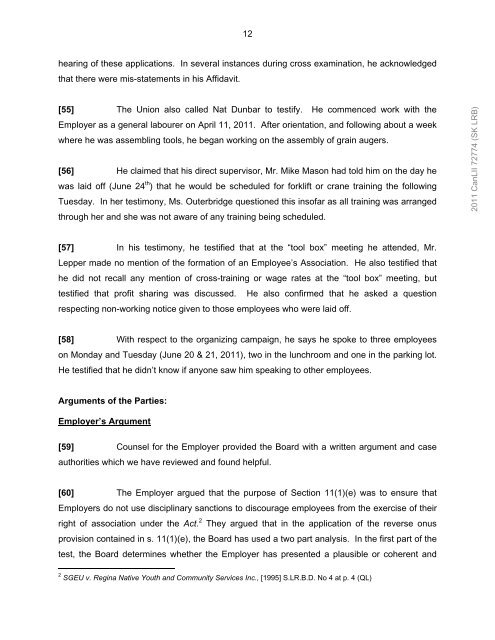FAQ's Cases - Stewart McKelvey
FAQ's Cases - Stewart McKelvey
FAQ's Cases - Stewart McKelvey
- No tags were found...
You also want an ePaper? Increase the reach of your titles
YUMPU automatically turns print PDFs into web optimized ePapers that Google loves.
12hearing of these applications. In several instances during cross examination, he acknowledgedthat there were mis-statements in his Affidavit.[55] The Union also called Nat Dunbar to testify. He commenced work with theEmployer as a general labourer on April 11, 2011. After orientation, and following about a weekwhere he was assembling tools, he began working on the assembly of grain augers.[56] He claimed that his direct supervisor, Mr. Mike Mason had told him on the day hewas laid off (June 24 th ) that he would be scheduled for forklift or crane training the followingTuesday. In her testimony, Ms. Outerbridge questioned this insofar as all training was arrangedthrough her and she was not aware of any training being scheduled.2011 CanLII 72774 (SK LRB)[57] In his testimony, he testified that at the “tool box” meeting he attended, Mr.Lepper made no mention of the formation of an Employee’s Association. He also testified thathe did not recall any mention of cross-training or wage rates at the “tool box” meeting, buttestified that profit sharing was discussed. He also confirmed that he asked a questionrespecting non-working notice given to those employees who were laid off.[58] With respect to the organizing campaign, he says he spoke to three employeeson Monday and Tuesday (June 20 & 21, 2011), two in the lunchroom and one in the parking lot.He testified that he didn’t know if anyone saw him speaking to other employees.Arguments of the Parties:Employer’s Argument[59] Counsel for the Employer provided the Board with a written argument and caseauthorities which we have reviewed and found helpful.[60] The Employer argued that the purpose of Section 11(1)(e) was to ensure thatEmployers do not use disciplinary sanctions to discourage employees from the exercise of theirright of association under the Act. 2 They argued that in the application of the reverse onusprovision contained in s. 11(1)(e), the Board has used a two part analysis. In the first part of thetest, the Board determines whether the Employer has presented a plausible or coherent and2 SGEU v. Regina Native Youth and Community Services Inc., [1995] S.LR.B.D. No 4 at p. 4 (QL)
















